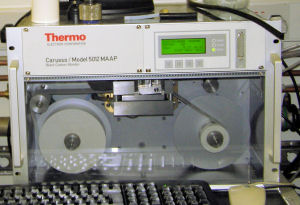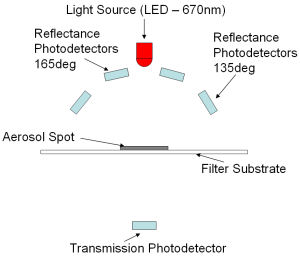Multi Angle Absorption Photometer (MAAP) and Particulate Soot Absorption Photometer (PSAP).

The MAAP and PSAP both measure black carbon mass loadings based on aerosol optical absorption. Both these instruments in common with Aethalometers make this measurement on particles collected on a filter substrate. However there are some important differences in how the two instruments operate and the algorithms used to extract the absorption coefficient and mass loading. These instruments aim to measure the same parameters as the Photo Acoustic Soot Spectrometer.
Particulate Soot Absorption Photometer (PSAP)
The PSAP manufactured by Radiance Research Inc. measures the change in optical transmission of a filter as aerosol is deposited on the filter over time. This measurement is made at 3 wavelengths (467, 530 and 660nm), the instrument has a 10s time resolution and typically operates with a flow rate of around 1 litre/min. The change in transmission from one measurement to the next is related to the optical absorption coefficient (bap m-1) of the aerosol deposited in this time period by:

Where AREA is the collection area of the filter, VOLUME is the volume of air sampled in the sampling interval, I is the current transmitted intensity, I0 is the transmitted intensity for the previous sample and f(Tr) is the filter correction factor which is a function of absolute transmission.
In turn this can be related to black carbon mass by dividing by the specific absorption for black carbon at the wavelength of the instrument. In the case of the PSAP (530nm channel) this is given as 10m2/g.
Comparisons between the PSAP aerosol optical absorption measurement and reference techniques presented by Bond et al (1999), show that the PSAP also responds to pure scattering particles and external mixtures of scattering and absorbing particles. This is because back scatter from scattering particles on the filter reduces the transmitted intensity. Bond et al show that the apparent absorption coefficient of purely scattering particles as measured by the PSAP is about 2% of their scattering coefficient. Additionally even when the PSAP measurement is corrected for errors in flow rate, collection spot area and the presence of scattering particles, the same series of experiments showed that PSAP optical absorption coefficients were about 20% higher than the reference measurement for the type of aerosol used. Thus PSAP data must be carefully calibrated and corrected based on measurements of aerosol scattering coefficient.
Multi Angle Absorption Photometer (MAAP)

The MAAP instrument (Thermo-Scientific model 5012) was specifically developed to reduce the uncertainties in black carbon measurements caused by aerosol scattering as described above. In the MAAP instrument the optical absorption coefficient of aerosol collected on a filter is determined by radiative transfer considerations which include multiple scattering effects and absorption enhancement due to reflections from the filter. This calculation is based on the transmitted and reflected phase functions which are defined by directly measured values of transmission, direct and diffuse back scattering. Full details of the algorithms used are given by Petzold et al (2002 and 2004). Lab work showed that the diffuse back scatter component was a strong function of the fraction of scattering aerosol, being decreased (relative to the filter) for low scattering fractions and increased for high scattering fractions. This lab work also informed the choice of angles for the detectors used. A schematic of the MAAP optical head is shown in figure 2. Comparisons between the MAAP technique and the thermal reference method presented by Petzold et al (2002) for various types of test and ambient aerosol showed that a constant specific absorption can be used to convert optical absorption coefficient to black carbon mass. The following equations are used by the MAAP instrument to calculate black carbon mass loading:

where MBC is the mass of black carbon deposited on the filter, ω0 is the single scattering albedo (determined from the radiative transfer considerations described above), tr is the transmittance, AREA is the area of the collection spot (2cm2) and σBC is the specific absorption of black carbon (6.6m2/g)

where CBC is the black carbon mass loading (mass per unit volume of air), ΔMBC is the difference in MBC from the previous sample and VOL is the volume of air sampled.
The MAAP operates at 670nm, has a 10s time response, features automatic filter changing based on absolute transmission, constant sample flow rate (1000 litre/hour) controlled by a variable speed pump and recording of the actual sample flow, making it an ideal instrument for unattended long term monitoring of black carbon mass loadings.
Internally Mixed Aerosol
The radiative transfer scheme used by the MAAP and the calibration corrections applied to the PSAP make the assumption that the pure scattering material exists as separate particles than the absorbing material. This is often referred to as an external mixture. However it is increasingly recognised that absorbing particles often consist of a core of black carbon coated with a layer of scattering material (usually sulphates or secondary organic material). This is known as an internal mixture. Mie calculations using a core – shell model and laboratory studies have shown that a thick sulphate or organic carbon coating on a black carbon core can enhance optical absorption by up to a factor of 3 (Andreae and Gelencser 2006). Thus any instrument which infers black carbon mass from aerosol optical absorption is likely to overestimate black carbon mass when particles are internally mixed. Such particles have frequently been observed in aged polluted air masses in measurements made with the Single Particle Soot Photometer (SP2).
Brown Carbon
The discussion so far has assumed that black or elemental carbon (material consisting almost entirely of carbon with a very low hydrogen or oxygen content and having a graphite like structure) is the only light absorbing constituent of atmospheric aerosol. While it is true that this is the most strongly absorbing component, it is increasingly recognised that certain organic carbons such as soil humics, humic like material, organic carbons produced in smouldering combustion and some bioaerosols are also light absorbing, but to a lesser extent. These materials are often referred to as brown carbon. Light absorption by brown carbon has a different spectral dependency than black carbon, absorbing much more strongly towards the ultra violet than the infra-red. In general the spectral dependence of absorption is described by a power law:
![]()
where αabs is the specific absorption of the particles, K is a constant which includes aerosol mass concentration, λ is the wavelength of the light, and Åabs is the Angstrom exponent for absorption.
In particles where the main absorbing material is black carbon the Angstrom exponent is close to 1, whereas for different types of brown carbon this value ranges from 2-7 (Andreae and Gelencser 2006).
Measurements of aerosol absorption coefficient at long wavelengths (red / infra red) will be almost unaffected by the presence of brown carbon, potentially leading to an underestimation of the absorption in the U-V. This is important in terms of quantifying radiative forcing and photochemistry in the atmosphere. It is also thought that brown carbon may be at least as important as black carbon in changing the albedo of snow covered surfaces and enhancing glacial melting rates.
In order to measure absorption by brown carbon, multiple wavelength versions of instruments such as the PSAP, PASS and Aethalometer are used. Simultaneous measurements at multiple wavelengths allow the black carbon contribution to be determined from measurements at long wavelength and then be subtracted from measurements at short wavelength leaving the contribution from brown carbon. Measurements at a sufficient number of wavelengths allow the Angstrom exponent for the aerosol to be determined giving an indication of the type of brown carbon present.
References
Andreae MO and Gelencser A, Black carbon or brown carbon? The nature of light absorbing carbonaceous aerosols. Atmospheric Chemistry and Physics, 6, 3131-3148, 2006.
Bond TC, Anderson TL, Campbell D, Calibration and intercomparison of filter-based measurements of visible light absorption by aerosols. Aerosol Science and Technology 30, 582–600, 1999
Petzold A, Kramer H, and Schönlinner M, Continuous Measurement of Atmospheric Black Carbon Using a Multi-angle Absorption Photometer. Environmental Science and Pollution Research, Special Issue 4, 78-82, 2002.
Petzold A and Schönlinner M, The Multi-angle absorption photometer – A new method for the measurement of aerosol light absorption and atmospheric black carbon. Journal of Aerosol Science, 35, 421-441, 2004.